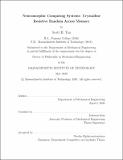| dc.contributor.advisor | Jeehwan Kim. | en_US |
| dc.contributor.author | Tan, Scott H.(Scott Howard) | en_US |
| dc.contributor.other | Massachusetts Institute of Technology. Department of Mechanical Engineering. | en_US |
| dc.date.accessioned | 2020-10-08T21:30:12Z | |
| dc.date.available | 2020-10-08T21:30:12Z | |
| dc.date.copyright | 2020 | en_US |
| dc.date.issued | 2020 | en_US |
| dc.identifier.uri | https://hdl.handle.net/1721.1/127915 | |
| dc.description | Thesis: Ph. D., Massachusetts Institute of Technology, Department of Mechanical Engineering, May, 2020 | en_US |
| dc.description | Cataloged from the official PDF of thesis. | en_US |
| dc.description | Includes bibliographical references (pages 129-142). | en_US |
| dc.description.abstract | Neuromorphic computing is a promising approach for efficient electronics by shaping computer hardware like the human brain. At the core of neuromorphic architectures are artificial synapses, which store conductance states to weight collections of electrical spikes according to Kirchoff's laws and Ohm's law. This thesis presents Silicon (Si)-based crystalline resistive random-access memory (crystalline RRAM) artificial synapses for neuromorphic computing. The main scaling bottleneck is poor temporal and spatial uniformity of artificial synapses. To the best of the author's knowledge, crystalline RRAM reported in this thesis have the lowest switching variations compared to other RRAM types. Controlling metal movement in resistive switching materials is extremely challenging. This thesis demonstrates two strategies to improve nanoscale control in crystalline RRAM: 1) intrinsic semiconductor regulation and 2) active metal alloying. | en_US |
| dc.description.abstract | The first strategy relies on using defects to regulate resistive switching. Epitaxially-grown Silicon-Germanium (SiGe) on Si permits resistive switching via dislocations. Defect-selective chemical etching can increase ON/OFF ratio while maintaining low variations. The second approach to improve crystalline RRAM is active metal alloying. Pure silver (Ag) exhibits high mobility in Si due to thermodynamic repulsion between Ag and Si. Thermodynamic instability of Ag in Si induces poor weight stability, especially in low conductance states. This thesis demonstrates that adding a small amount of copper (Cu) to pure Ag can enhance weight stability because Cu can act as a bridge between Ag and Si to alleviate thermodynamic repulsion. Convolutional filtering and weight storage with 32 x 32 crystalline RRAM crossbar arrays are experimentally demonstrated using this approach. While these results are extremely promising, 2D crossbar scaling is limited by sneak currents. | en_US |
| dc.description.abstract | Stacking artificial synapses in 3D could maximize scaling potential. However, 3D crystalline RRAM cannot be fabricated with single-crystalline materials that require high growth temperatures. Poly-crystalline Si could form 3D crystalline RRAM, however, resistive switching performance is inferior to single-crystalline RRAM, possibly due to free bonds. This thesis demonstrates hydrogen passivation can fix this problem. Hydrogenated doped poly-crystalline/micro-crystalline Si are presented as suitable materials for 3D neuromorphic computing cores. To conclude this thesis, monolithic character classifiers with micro-crystalline imaging and computing units are designed. | en_US |
| dc.description.statementofresponsibility | by Scott H. Tan. | en_US |
| dc.format.extent | 142 pages | en_US |
| dc.language.iso | eng | en_US |
| dc.publisher | Massachusetts Institute of Technology | en_US |
| dc.rights | MIT theses may be protected by copyright. Please reuse MIT thesis content according to the MIT Libraries Permissions Policy, which is available through the URL provided. | en_US |
| dc.rights.uri | http://dspace.mit.edu/handle/1721.1/7582 | en_US |
| dc.subject | Mechanical Engineering. | en_US |
| dc.title | Neuromorphic computing systems : crystalline resistive random access memory | en_US |
| dc.type | Thesis | en_US |
| dc.description.degree | Ph. D. | en_US |
| dc.contributor.department | Massachusetts Institute of Technology. Department of Mechanical Engineering | en_US |
| dc.identifier.oclc | 1197727493 | en_US |
| dc.description.collection | Ph.D. Massachusetts Institute of Technology, Department of Mechanical Engineering | en_US |
| dspace.imported | 2020-10-08T21:30:11Z | en_US |
| mit.thesis.degree | Doctoral | en_US |
| mit.thesis.department | MechE | en_US |
